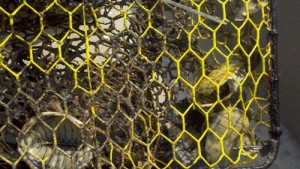
OCEAN CITY – In an effort to stabilize the local diamond back terrapin population, Maryland Coastal Bays Program (MCBP) is working with a local waterman to remove abandoned crab pots in the watershed.
The MCBP and local waterman Jamie Steele are asking for assistance with a mini-grant to be awarded to Steele to continue the effort to remove “ghost crab pots” from the local waterways.
Last December, Steele was awarded a mini-grant from MCBP to recover crab pots that sink and remain on the floor of the bays. Steele ended up removing 82 pots last year in the Assawoman Bay, Isle of Wight Bay, Sinepuxent Bay and Newport Bay.
Ghost crab pots claim the lives of several different marine life species, especially the beloved state reptile, the diamond back terrapin.
MCBP’s Sandi Smith explained commercial crab pots are not required to have turtle excluders but privately owned ones are, and most of the time the pots that have buoys removed and sink are commercial.
“Turtles are attracted to them because they have bait in there,” Smith said. “They get in there just like crabs do and can’t get back out again, and turtles obviously need to breathe … so they basically drown and you lose a lot of turtles, and other aquatic life … it is really devastating on the terrapin population.”
MCBP has mini-grant programs available to citizens that want to steward the bays, such as was the case with Steele who has taken advantage of the program to remove ghost crab pots.
“The grant that he took advantage of was for the year 2012-2013, he obviously performed his in 2012 but I don’t have the funding to give him a new one in November,” Smith said. “He would have to wait until the next grant cycle, which comes out in July.”
Steele explained a grant is required to legally recover commercial crab pots from the floor of the local bays. He feels if he were to be awarded the grant by the end of the crab season in mid-October he would be able to recover a greater number of pots beginning in November than in December.
“Last year the grant was so late by the time I got out there it was freezing cold, so obviously I was out there for only so long,” Steele said. “Also, my point to them [MCBP] is if we got the grant earlier enough when I could get out there in November and there are different methods I could use to try to recover crab pots.”
The mini-grant will allow Steele five days to explore the areas of the Assawoman Bay, Isle of Wight Bay, Sinepuxent Bay and Newport Bay to remove ghost crab pots. Being a local waterman he tends to keep track of the crab pots throughout the crabbing season and knows where to look for those that have been abandoned.
“Once the crab pots begin to grow barnacles, the buoy becomes heavy, and they will sink or somebody can ride by at night and cut the buoy and the pot will sink,” he said.
Not only are ghost crab pots a death trap for marine life, they also become a safety hazard for watermen and boaters.
“As a waterman, there are a lot of people that will cut our buoys off. We have had plenty of people pull our pots and steal crabs out of them … please don’t tamper with other people’s pots,” Steele said. “It sounds minor but you wouldn’t believe how many people steal each year.”
If interested in assisting MCBP to award a mini grant to recover ghost crab pots or to participate in the third annual terrapin count May 29- June 1, contact Smith at [email protected].
MCBP exists to protect and conserve the waters and surrounding watershed of Maryland’s five coastal bays located behind Ocean City and Assateague Island. The watershed includes more than 189,000 acres of land, 71,000 acres of water, 248 miles of shoreline, and nearly 35,000 acres of wetlands. Living within its boundaries is a variety of wildlife, including 360 different types of birds, as well as more than 108 rare, endangered and threatened species.
